Apple 15-inch MacBook Pro (Late 2011) Review
by Anand Lal Shimpi on November 17, 2011 5:10 PM EST- Posted in
- Mac
- Apple
- Intel
- MacBook Pro
- Sandy Bridge
- Laptops
The early 2011 MacBook Pro is honestly Apple's best effort to date. Only using quad-core CPUs on the 15 and 17-inch models, and offering an optional Thunderbolt Display that can act as a modern day dock makes this platform, particularly the 15-inch model, the perfect candidate for users who want the power and flexibility of a desktop with the portability of a notebook. Apple gets the mobile revolution in more ways than one, and its MacBook Pro/Thunderbolt Display combo is the perfect example of that.
It's this very combination that I've been using, partially since the introduction of the Sandy Bridge MacBook Pro earlier this year (the Thunderbolt Display didn't arrive until later). I've been quite happy with the setup. With the exception of lackluster Quick Sync adoption by Apple and obviously limited GPU options, I have very few major complaints.
Late last month, Apple updated its 2011 MacBook Pro lineup - likely the first and last update before Apple adopts Ivy Bridge in Q2 next year. We got our hands on the new base 15-inch MacBook Pro configuration, which received one of the more substantial upgrades over the previous model. As this is still a fairly minor upgrade, be sure to read our original review of the platform for a deeper dive into all of the aspects of the system.
| Late 2011 MacBook Pro Lineup | |||||||
| 13-inch (low end) | 13-inch (high end) | 15-inch (low end) | 15-inch (high end) | 17-inch | |||
| Dimensions |
0.95 H x 12.78 W x 8.94 D
|
0.95 H x 14.35 W x 9.82 D
|
0.98 H x 15.47 W x 10.51 D
|
||||
| Weight |
4.5 lbs (2.04 kg)
|
5.6 lbs (2.54 kg)
|
6.6 lbs (2.99 kg)
|
||||
| CPU |
2.4 GHz dual-core Core i5
|
2.8 GHz dual-core Core i7
|
2.2 GHz quad-core Core i7
|
2.4 GHz quad-core Core i7
|
2.4 GHz quad-core Core i7
|
||
| GPU |
Intel HD 3000 Graphics
|
Intel HD 3000 + AMD Radeon HD 6750M (512MB)
|
Intel HD 3000 + AMD Radeon HD 6770M (1GB)
|
Intel HD 3000 + AMD Radeon HD 6770M (1GB)
|
|||
| RAM |
4GB 1333MHz DDR3 (8GB max)
|
||||||
| HDD |
500GB 5400 RPM
|
750GB 5400 RPM
|
500GB 5400 RPM
|
750GB 5400 RPM
|
750GB 5400 RPM
|
||
| Display Resolution |
1280x800
|
1440x900 (1680x1050 optional)
|
1920x1200
|
||||
| Ports |
Gigabit LAN, Firewire 800, Thunderbolt, 2x USB 2.0, SDHC slot, combined audio in/out jack
|
Gigabit LAN, Firewire 800, Thunderbolt, 2x USB 2.0, SDHC slot, separate audio in/out jacks
|
Gigabit LAN, Firewire 800, Thunderbolt, 3x USB 2.0, separate audio in/out jacks, ExpressCard 34 slot
|
||||
| Battery Capacity |
63.5Wh
|
77.5Wh
|
95Wh
|
||||
| Price | $1,199 | $1,499 | $1,799 | $2,199 | $2,499 | ||
Silicon Updates
The focus of Apple's late 2011 update, despite rumors to the contrary, was on the silicon inside the platform. As the Mac business is a relatively mature one, we can expect a slower pace of chassis and design upgrades compared to the iPhone/iPad businesses for example.
We'll start with the CPU, the lesser updated chip in the new MacBook Pro. System pricing hasn't changed, but CPU speeds have all gone up.
Just as before the 15-inch MacBook Pro is only available with a quad-core Intel Core i7 CPU (codename Sandy Bridge). The $1799 configuration goes from a 2.0GHz i7 to a 2.2GHz model. Be warned, this isn't the same 2.2GHz model that was available as an upgrade earlier this year though.
A quick run of Cinebench points out that the 2.2GHz i7 in our system may be a Core i7 2675QM. The original 2.2GHz option was a Core i7 2720QM. What's the difference between the two? Not a whole lot.

Max turbo is down a bit on the 2675QM. It was 3.3GHz on the 2720, but now it's 3.1GHz. The two, three and four core turbo limits are also down by 200MHz compared to what they were in early 2011. If you didn't have a 2.2GHz early 2011 15-inch MacBook Pro, these differences likely don't mean anything. If for whatever reason you're comparing to an early 2011 2.2GHz model, you'll see a slight regression in CPU bound performance.
The on-die GPU is a hair slower as well. You still get an Intel HD 3000 GPU (12 EUs) but the max turbo moves from 1.3GHz down to 1.2GHz. Or if you prefer another way of looking at it, the 2675QM is the same as the 2670QM, except the GPU is able to clock 100MHz higher (1.2GHz vs. 1.1GHz).
| Apple 15-inch Late 2011 MacBook Pro CPU Comparison | |||||
| 2.2GHz quad-core | 2.4GHz quad-core | 2.5GHz quad-core | |||
| Intel Model | Core i7-2675QM | Intel Core i7-2760QM | Intel Core i7-2860QM | ||
| Base Clock Speed | 2.2GHz | 2.4GHz | 2.4GHz | ||
| Max SC Turbo | 3.1GHz | 3.5GHz | 3.6GHz | ||
| Max DC Turbo | 3.0GHz | 3.4GHz | 3.5GHz | ||
| Max QC Turbo | 2.8GHz | 3.2GHz | 3.3GHz | ||
| L3 Cache | 6MB | 6MB | 8MB | ||
| AES-NI | Yes | Yes | Yes | ||
| VT-x | Yes | Yes | Yes | ||
| VT-d | No | Yes | Yes | ||
| TDP | 45W | 45W | 45W | ||
The upgraded 15-inch configuration comes with an all new Sandy Bridge SKU: the Core i7 2760QM running at 2.4GHz. Unlike the old 2.3GHz part, the 2760QM still only has a 6MB L3 cache. You do get higher base and turbo speeds. There's also a new 2.5GHz quad-core option that can run at up to 3.6GHz with a single core active. That's an absolutely insane frequency for a notebook. Notebook-as-a-desktop users will appreciate the flexibility here.
All of the new CPUs support AES-NI, although once again Apple is the victim of Intel's silly segmentation. The entry level 2.2GHz part does not support VT-d (Virtualization Technology for Directed I/O), which allows virtual machines to have direct access to I/O devices (including PCIe GPUs). I'm not sure if any current virtualization software for OS X supports VT-d, but the absence of the feature is important to note nonetheless. The rest of the CPU lineup supports VT-d.

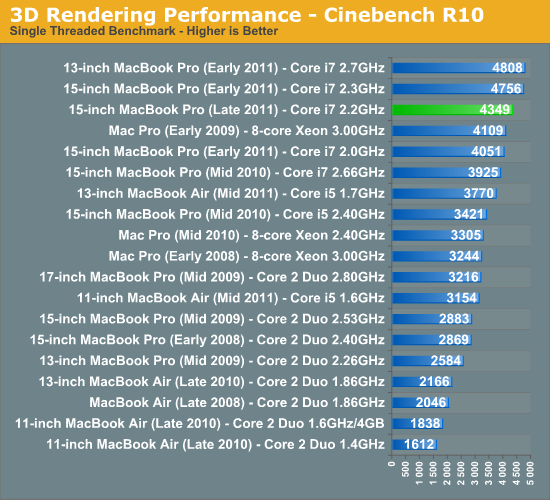
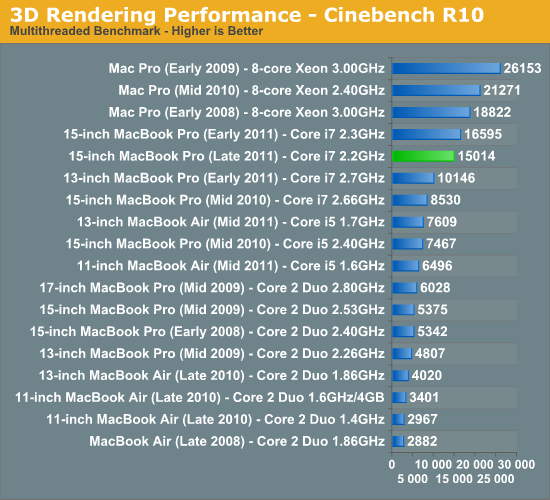
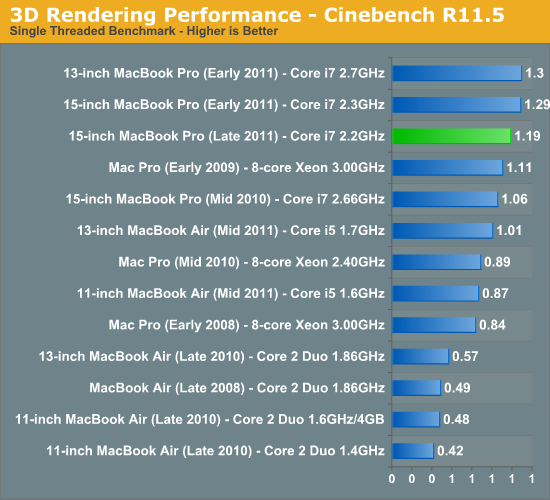
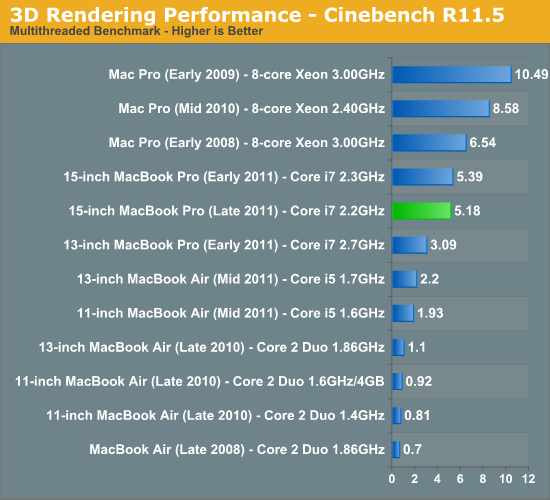
Battery Life
TDPs haven't changed, nor has the MacBook Pro's battery capacity, so overall battery life should (and does) remain relatively unchanged from the early 2011 models. Worst case scenario you can expect around 2.5 hours of battery life under load. With moderate load expect 4 - 5 hours of use on a single charge. And under a very light load you can easily exceed 7 hours.
I ran our normal battery life suite, however Lion has made some of the numbers a little less comparable than I would've liked. The lighter use cases (e.g. our web browsing tests) see a drop compared to our older Snow Leopard results. Under full load the new platform, even while running Lion, actually did a bit better than its predecessor. All in all I'd say the new MacBook Pro is pretty consistent with its predecessor - Lion just threw a wrench in a lot of our battery life comparisons so we'll be starting over from scratch in building our new database.
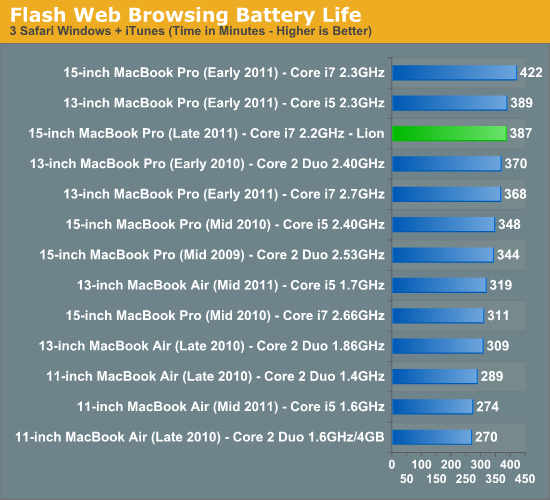
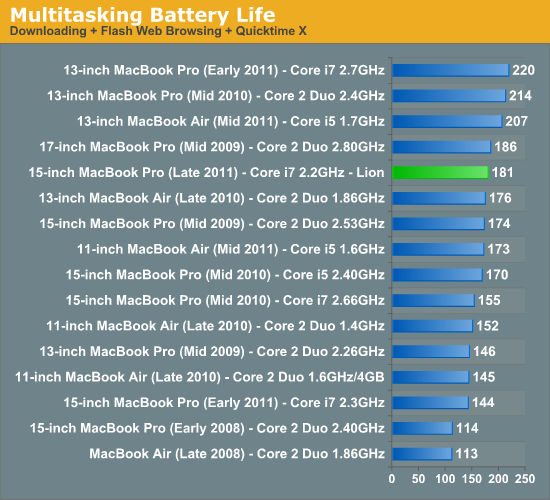


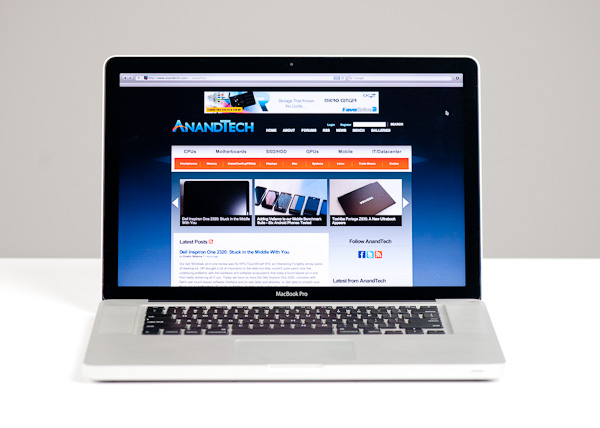

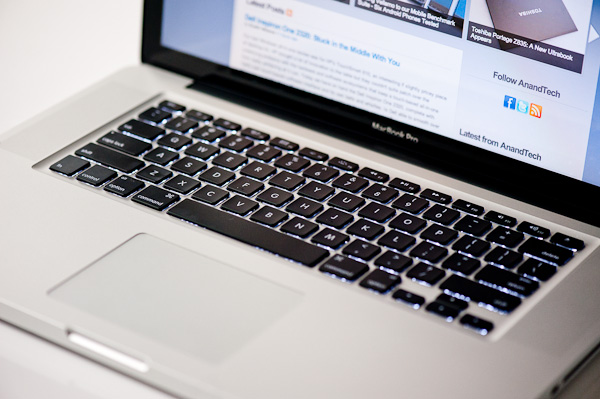








101 Comments
View All Comments
ananduser - Sunday, November 20, 2011 - link
OpenGL drivers are also better and actually up to date compared to OSX, you keep to omit that.Back in 2011(your link is a test from 2008) there are Win7 ultrabooks(that come to mind) that offer at least comparable battery life with the most recent Air. Anand should use desktop Flash browsing in his browsing tests so as to provide more realistic battery life patterns.
KoolAidMan1 - Sunday, November 20, 2011 - link
Are you really being this nitpicky? When I talk about video drivers being more up to date in Windows, I figure that both DX and OpenGL can be inferred. The only reason I wasn't as specific is because nothing (not even Carmack's RAGE) uses OpenGL in Windows these days. I didn't think it was even worth mentioning given that DirectX is the standard, so much so that even he threw in the towel.If you can't infer that then maybe I need to spell everything out for you from now on. Either way it doesn't change my core criticisms that video drivers from GPU manufacturers are more up to date than the ones that Apple puts out much less frequently on their own.
As for recent Win7 ultrabooks, I expect that the battery life results would be similar with the same hardware as the Air given that Windows 7 and Vista are still roughly in line with each other. Win7 is actually marginally worse in terms of battery life if I'm not mistaken.
Either way, the test is from 2008 but I don't expect the results to be any different on similar hardware given that Win7 hasn't yielded any improvements in that area.
Regarding tests with and without Flash, he's always very clear when he's having it off or on. In the case of the 2008 test it wasn't mentioned, so I have to assume that Flash was used in both tests.
You seem to be desperately looking for excuses.
ananduser - Sunday, November 20, 2011 - link
I was under the malevolent influence of your nick :).The Verge's and Engadget's recent ultrabook reviews yielded similar battery life across the board. One exception is that of Sammy's Series 9, but that is a significantly older part. Toshiba's Protege actually has the highest battery life out of the pack(Air included). So NO, things have changed since 2008, and your axiom is wrong.
Why would I care so much to look for excuses ?
Death666Angel - Friday, November 18, 2011 - link
"it would have to wait until Haswell, where integrated graphics performance is supposed to be much better."I still hope that AMD can deliver good CPU performance within the next year or two. Do you think Apple will ever bother with AMD, even if they become competitive again?
Vepsa - Friday, November 18, 2011 - link
I really want one of these. However, I want to know what you guys do with your review machines too. If you don't have to send this one back, I'll take it ;)TheGeoff - Friday, November 18, 2011 - link
Cool. Glad to hear they addressed that.MobiusStrip - Friday, November 18, 2011 - link
At least you can now GET the matte screen on the 15" (for an extra $150, or $50 more than the optional higher-res screen), although it's still inexplicably not available on the machines that are most likely to leave the house: the 13" MBP and the Airs.After many, many hours working with matte and glossy screens under all lighting conditions, you'll realize: glossy screens suck. This asinine fad is the biggest regression in computing since... what?
It's time that reviews call this out instead of and make it a marketing liability that Apple and others can't ignore, instead of (yes, here it comes) GLOSSING OVER IT.
tzhu07 - Monday, November 21, 2011 - link
Yes, totally. I don't understand the glossy trend. When I was in the market for a 2560 monitor, I had to immediately eliminate the Apple 27" display because of the glossy screen. They lost $1,000 from a customer by default.NEC ended up with my money for the PA271W.
MadMacMan - Friday, November 18, 2011 - link
Wait for Haswell? What the hell? You might as well never get any notebook or computer of any kind for that matter, as something better is always on the horizon. Even Ivy Bridge is 6-8 months too far into the future as far as I'm concerned.I just discovered this site and spent four hours reading reviews and benchies last night. lol...It works so well for me because Anand thinks like me when it comes to wanting your cake and eating it, too, with using a 15" or 17" MacBook Pro along with a 27" ThunderBolt / (LED) Cinema Display. Right down to using the Magic Trackpad instead of a mouse. haha...that's awesome!
Well, this setup has really only been possible on a more serious level since Sandy Bridge and ThunderBolt. It is about to get even sweeter once there are ThunderBolt adapters and devices coming out, such as the Sonnet TB --> ExpressCard/34 adapter and PCIe expansion enclosures that will allow multiple full-length PCIe cards to be added to a *laptop*, something that still requires a Mac Pro today.
Finally, I actually wanted to add something to this review that wasn't mentioned and that has been a thorn in my eye with the 2011 (Early as well as Late). The 15" and 17" MBP's SATA III implementation STILL doesn't work in the optical drive bay! I have two OWC Mercury EXTREME Pro SATA III (6Gbps) SSD's that I used to get upwards of 900MB/s (and over 100,000 IOPS) in a Mac mini server before I switched (back) to this (laptop+display) model. Even more infuriating is the fact that the 13" MBP works just fine with SATA III SSD's in *both* bays! Grrr! Yes, I realize that Apple not only didn't advertise the fact that SATA III drives can be used since its Early-2011 MBP models, but they haven't even so much as mentioned it in any of its marketing materials. Whatever...I'm back down to 550MB/s using just one of my solid state drives. (P.S.: Yes, I know, first world problem...)
umesh - Saturday, November 19, 2011 - link
Has anyone noticed that the second table above reads "Apple 15-inch Late 2011 MacBook Pro CPU Comparison", whereas the listed processors all belong to the EARLY 2011 MBP models?